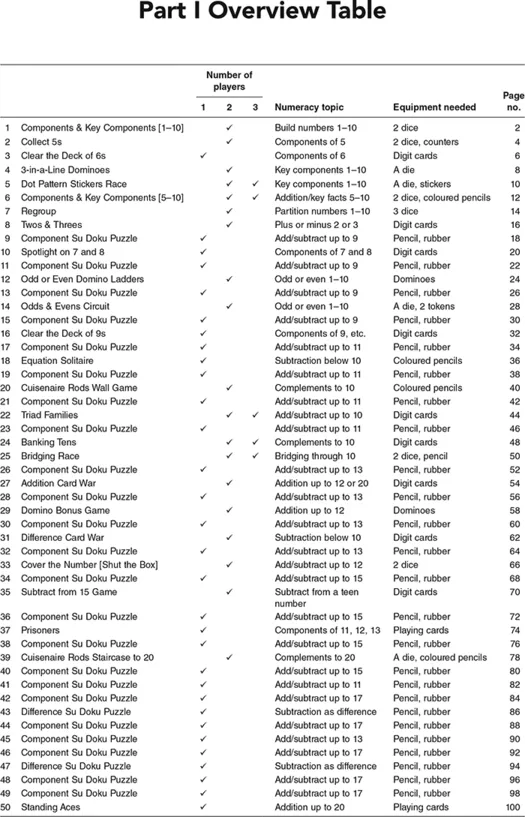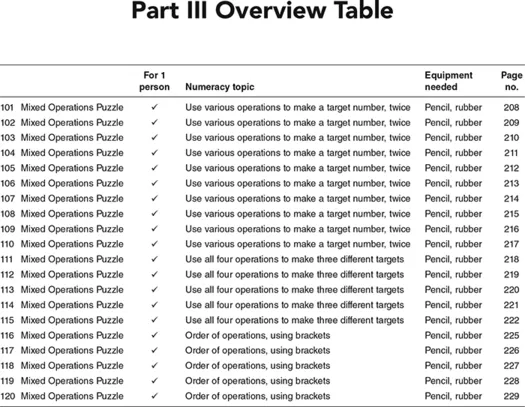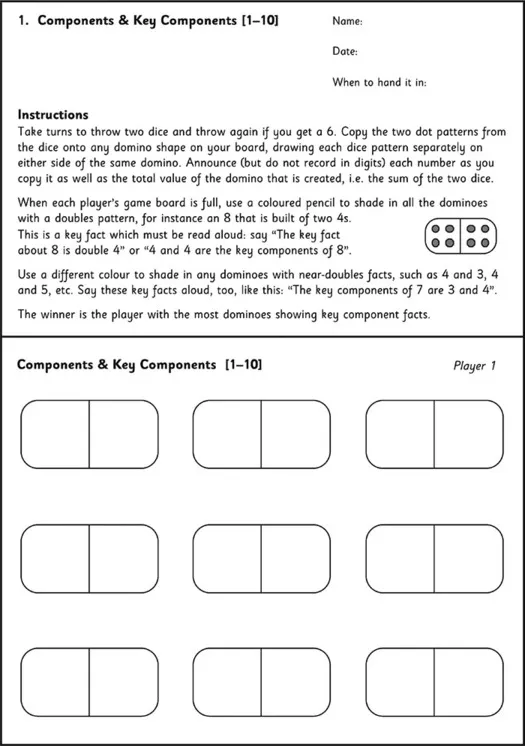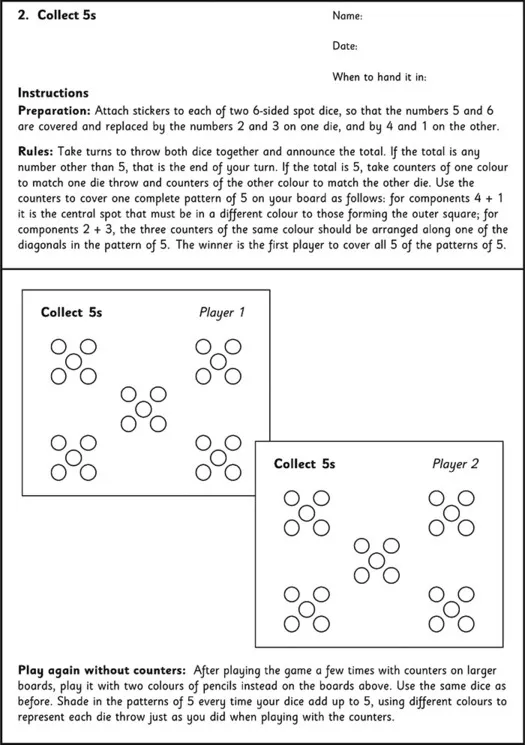
eBook - ePub
The Dyscalculia Resource Book
Games and Puzzles for ages 7 to 14
Ronit Bird
This is a test
Partager le livre
- 272 pages
- English
- ePUB (adapté aux mobiles)
- Disponible sur iOS et Android
eBook - ePub
The Dyscalculia Resource Book
Games and Puzzles for ages 7 to 14
Ronit Bird
Détails du livre
Aperçu du livre
Table des matières
Citations
À propos de ce livre
Written by a teacher for teachers, the second edition of Ronit Bird's The Dyscalculia Resource Book now comes with 120 games and puzzles and a brand new section on 'mixed operations puzzles' which require learners to switch mentally between addition, subtraction, multiplication and division.
The new edition will also provide access to an accompanying website featuring demo videos of different games and puzzles and the option to easily download and print all the games and puzzles in the book!
Ideal for working with students 7 to 14 years old, this is the perfect companion to The Dyscalculia Toolkit, essential additions to every teachers' resource collection.
Foire aux questions
Comment puis-je résilier mon abonnement ?
Il vous suffit de vous rendre dans la section compte dans paramètres et de cliquer sur « Résilier l’abonnement ». C’est aussi simple que cela ! Une fois que vous aurez résilié votre abonnement, il restera actif pour le reste de la période pour laquelle vous avez payé. Découvrez-en plus ici.
Puis-je / comment puis-je télécharger des livres ?
Pour le moment, tous nos livres en format ePub adaptés aux mobiles peuvent être téléchargés via l’application. La plupart de nos PDF sont également disponibles en téléchargement et les autres seront téléchargeables très prochainement. Découvrez-en plus ici.
Quelle est la différence entre les formules tarifaires ?
Les deux abonnements vous donnent un accès complet à la bibliothèque et à toutes les fonctionnalités de Perlego. Les seules différences sont les tarifs ainsi que la période d’abonnement : avec l’abonnement annuel, vous économiserez environ 30 % par rapport à 12 mois d’abonnement mensuel.
Qu’est-ce que Perlego ?
Nous sommes un service d’abonnement à des ouvrages universitaires en ligne, où vous pouvez accéder à toute une bibliothèque pour un prix inférieur à celui d’un seul livre par mois. Avec plus d’un million de livres sur plus de 1 000 sujets, nous avons ce qu’il vous faut ! Découvrez-en plus ici.
Prenez-vous en charge la synthèse vocale ?
Recherchez le symbole Écouter sur votre prochain livre pour voir si vous pouvez l’écouter. L’outil Écouter lit le texte à haute voix pour vous, en surlignant le passage qui est en cours de lecture. Vous pouvez le mettre sur pause, l’accélérer ou le ralentir. Découvrez-en plus ici.
Est-ce que The Dyscalculia Resource Book est un PDF/ePUB en ligne ?
Oui, vous pouvez accéder à The Dyscalculia Resource Book par Ronit Bird en format PDF et/ou ePUB ainsi qu’à d’autres livres populaires dans Éducation et Enseignement des mathématiques. Nous disposons de plus d’un million d’ouvrages à découvrir dans notre catalogue.
Informations
Overview Tables
Part I Overview Table

Part II Overview Table

Part III Overview Table

Part I Addition and Subtraction Games and Puzzles
1 Components & Key Components [1–10] – a game for 2 players
Teaching points
- The key components of all the numbers up to 10. The words ‘key components’ here refer to the doubles and near-doubles facts, e.g. 5 and 4 are the key components of 9.
- Practice in recognising the dice patterns.
- Only the numbers 1 to 5 (but not 6) are key components of the numbers up to 10.
- The same small number can be one of the key components of up to three larger numbers. For example, the number 4 is one of the key components of 7 and of 8 and of 9.
- Any number can be built by combining two smaller quantities (the basis of addition).
- Any number can be partitioned into two smaller components (the basis of subtraction).
Note to member of staff or parent
- Make sure the child is learning to recognise the dice patterns, not counting the dice spots.
- The child is not allowed to add by counting in ones, on fingers or otherwise. Anyone who is not yet at this stage should spend more time learning through concrete materials.
- Explain to the child that ‘key facts’ are so called because they are important facts that unlock a logical route to other, related facts. A focus on key facts, e.g. learning a single fact for each number up to 10, means minimising the number of facts that have to be committed to memory.
- Make sure the child understands what is meant by ‘key components’. For example, 5 and 4 are the key components of 9 because 5 + 4 is a near-doubles fact. Other components of 9 are 3 and 6, or 2 and 7, or 8 and 1, but these facts are not key facts.
- Point out to the child that the colouring task is a way of highlighting the most important combinations, i.e. the key component facts, not simply a way of scoring this game.
- Once both players have had nine turns each to throw the dice and draw the dominoes, it is the child who should undertake the scoring by finding, colouring and reading aloud the key facts on both players’ boards.
- The game should be played more than once and on more than one occasion.
Equipment needed
Two ordinary 6-sided spot dice. A second game board for an opponent. A pencil each and two coloured pencils in two different colours.

The Dyscalculia Resource Book © Ronit Bird, 2017 (SAGE)
2 Collect 5s – a game for 2 players
Teaching points
- There are only two ways of building the number 5 from two components.
- Inside the pattern of 5 one can see the pattern of 3 superimposed onto the pattern of 2.
- Inside the pattern of 5 one can see the pattern of 1 superimposed onto the pattern of 4.
- The commutativity of addition, i.e. 4 + 1 is the same as 1 + 4, and 2 + 3 = 3 + 2.
- Mental addition of two numbers below 5 to create a total of between 2 and 8.
- Moving away from using concrete materials in order to combine these small quantities and towards the stage of using visualisation techniques to find the answers mentally.
Note to member of staff or parent
- Make sure the child is recognising the dice patterns, not counting the dice spots.
- Make sure the child is not adding by counting in ones, on fingers or otherwise.
- Be sure to talk about what is going on at each step, especially when either player puts two components together to make 5.
- At first, prepare two game boards to suit the size of your counters.
- After playing a few times, preferably on different occasions, try the more abstract version of the game using the two boards on the next page.
Equipment needed
Two 6-sided spot dice, altered as follows: cover the patterns of 5 and 6 with a sticker and cover the stickers on one die with one pattern of 2 and one pattern of 3, and on the other die with one pattern of 4 and one pattern of 1. Counters in two colours (later, coloured pencils in two colours). Two paper game boards on which are drawn five patterns of 5, making sure the drawn circles roughly match the size of your counters.

The Dyscalculia Resource Book © Ronit Bird, 2017 (SAGE)
3 Clear the Deck of 6s – a game for 1 player
Teaching points
- Components of 6. There are only three ways of building the number 6 from two components.
- The connection between addition, subtraction and missing addend problems.
- Mental addition of two numbers up to a total of 10.
Note to member of staff or parent
- Make sure the child knows that adding in ones, on fingers or otherwise, is not allowed.
- As the child picks up pairs of cards during play, both numbers should be spoken aloud.
- Make sure the target number is spelled out clearly. Although the layout of the cards makes no difference to the game, an arrangement of two rows of three may act as a reminder of this game’s target number, which is 6.
- The game should be played more than once and on more than one occasion. Encourage the child to keep playing until the components of 6 are easily recognised, rather than calculated.
Equipment needed
A pack of cards made up of four each of the numbers 1 to 5 inclusive. If you have no digit cards, remove the appropriate cards from a standard pack of playing cards and treat the Aces as 1s.

The Dyscalculia Resource Book © Ronit Bird, 2017 (SAGE)
4 3-in-a-Line Dominoes – a game for 2 players
Teaching points
- The ke...